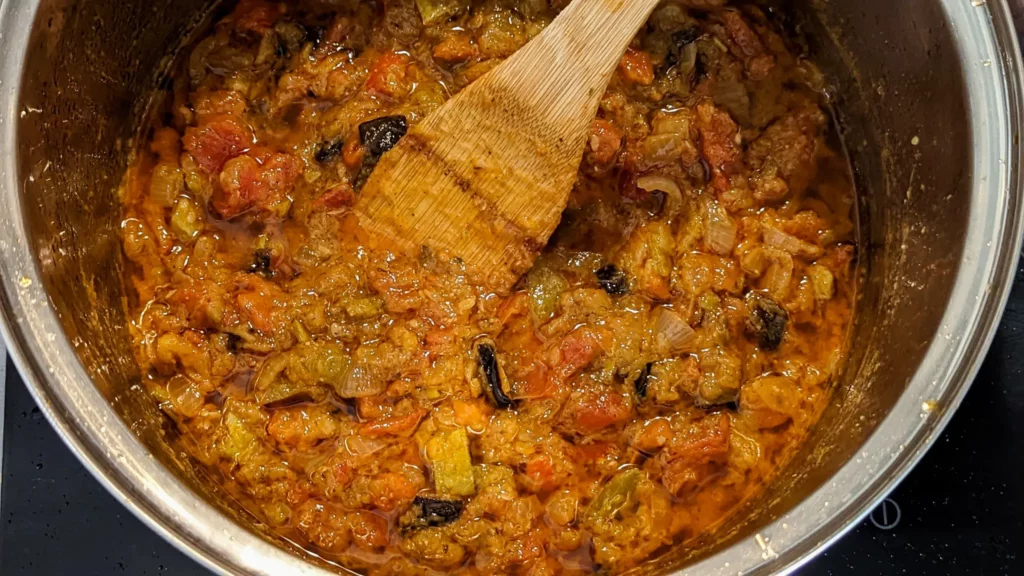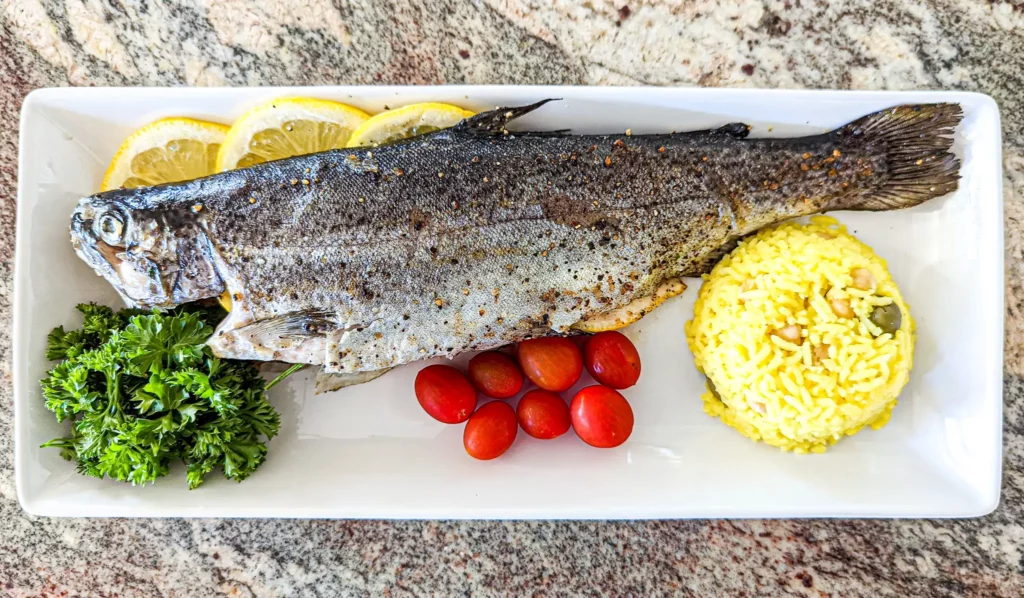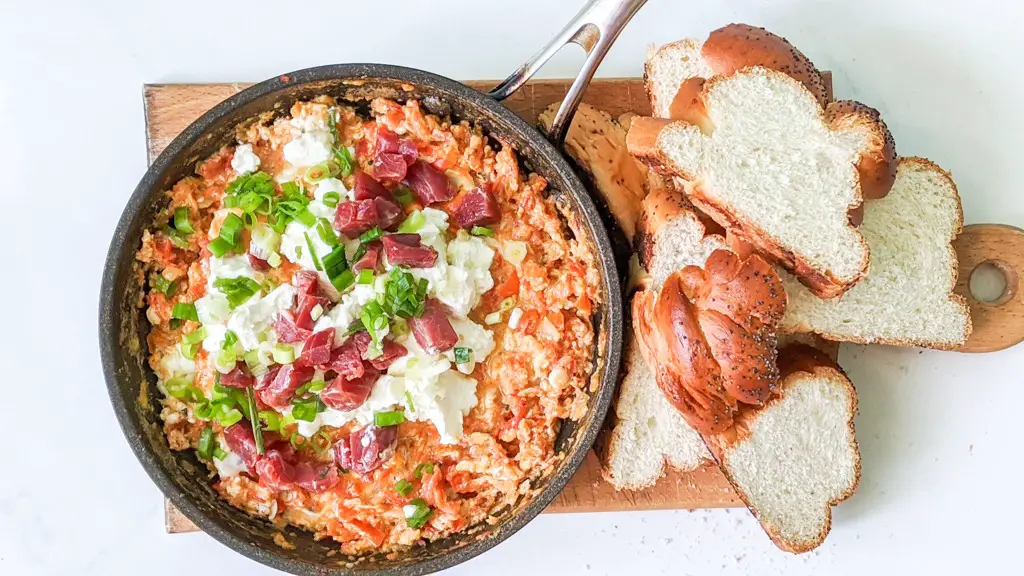There is little more comforting than a hearty stew made with high quality ingredients. A traditional Spanish pisto is one of my favorite Spanish recipes, as well as being one of my favorite tapas when I’m out on the town.

While not the most beautiful dish, this vegetable stew is packed with flavor. Not to mention the plethora of ways you can upgrade an authentic Spanish pisto with things like jamon or a fried egg.
Many people like to compare pisto with the French ratatouille or the Italian ciambotta, but there is a difference.
What Is Spanish Pisto?

Spanish pisto is a savory vegetable stew with tomatoes, eggplant, zucchini, onion, bell peppers, and olive oil. It is often called pisto manchego because it originated in the region of La Mancha (the region famous for windmills, cheese, and Don Quixote).
Pisto is eaten at all times of day Spain and is often served as a tapa with a slice of white bread in Andalusia. While traditional Spanish pisto is a vegan dish, many Spaniards add things like cured ham or fried eggs. Pisto is one of the most popular Spanish recipes across all generations.
How To Make A Traditional Spanish Pisto

As this is a vegetable stew most of the ingredients are, you guessed it, vegetables. While I like to use both eggplant (aubergine) and zucchini (courgette) in my Spanish pisto, many people opt for one or the other. I will leave that decision up to you.
Pisto Ingredients
- 1 large Eggplant – cut into cubes
- 1 large Zucchini – or two small ones, cut into cubes
- 2 Bell Peppers – traditionally people use half red and half green, but you can use whatever colors you like.
- 1 large Onion – diced
- 3 cloves Garlic – minced
- 1 teaspoon Spanish Paprika – this is a sweet type of paprika, not at all hot like the Hungarian version.
- 1 tablespoon Ajo y Perejil – this is a mix of dry parsley and granulated garlic. You can just use about 1.5 tsp of each if you can’t find this spice blend outside of Spain.
- Salt – to taste
- Olive Oil – as needed. Seriously, pisto is made with a LOT of olive oil. If you think you are using too much, don’t worry they probably use more in Spain.

One of the tricks I learned for making Spanish pisto came from an abuela I met during my time in Jaen. She said the trick is to fry everything separately before adding it to the stewpot. And ever since that lesson I’ve never made pisto differently.

In a pan add a healthy amount of olive oil and begin frying your ingredients. I like to start with the eggplant as I love when they really break down into the sauce. However for those of you who like more firm eggplant, you can fry them last. Lightly sprinkle each ingredient with a bit of salt to help draw water from the vegetable.

When the eggplant is nice and caramelized dump it all into a pot oil and all. Let the pot sit at a very low heat. Then add more oil to the pan and add in the zucchini. Fry the zucchini until browned then add it to the pot. Rinse and repeat with every ingredient.

After you have cooked all the ingredients in the pan and added them to the pot add about a cup of water and turn the heat up to medium. Add in the garlic, paprika, and parsley blend and give everything a good stir. Simmer the pisto until the water you added has evaporated and most of the vegetables have broken down.

The pot should look like a bit of a mess, but it is a very delicious mess if I say so myself. Yes it looks oily, but that is just more flavor to sop the bread in!

Depending on how long you cook this Spanish pisto will determine how broken down everything is. I have gotten it served from extremely chunky (probably simmered less than an hour) to almost a puree (could be a full day pisto) but the one truth is that it has always been delicious.

Tips & Tricks
- If you want a really broken down pisto you can use a potato masher to squash the vegetables and speed up the process.
- Spanish pisto makes a great tapa. One of my favorite restaurants in Granada does a pisto with octopus tart as a free tapa and I get it pretty much every time I go there.
- If you don’t want to use a lot of olive oil you can drain the vegetables before adding them to the pot. Alternatively you can add a little cornstarch to thicken the stew and make it less runny.

Spanish Pisto
Equipment
- 1 Pan for frying
- 1 Pot for stewing
Ingredients
- 6 medium Tomatoes cubed. You can use more or less, it is up to you. I use 6 medium tomatoes but if you like a very tomato-y stew feel free to add more
- 1 large Eggplant cut into cubes
- 1 large Zucchini or two small ones cut into cubes
- 2 Bell Peppers traditionally people use half red and half green but you can use whatever colors you like.
- 1 large Onion diced
- 3 cloves Garlic minced
- 1 teaspoon Spanish Paprika this is a sweet type of paprika not at all hot like the Hungarian version.
- 1 tablespoon Ajo y Perejil this is a mix of dry parsley and granulated garlic. You can just use about 1.5 tsp of each if you can't find this spice blend outside of Spain.
- Salt to taste
- Olive Oil as needed. Seriously pisto is made with a LOT of olive oil. If you think you are using too much, don't worry they probably use more in Spain.
Instructions
- Begin with cutting the eggplant and frying the cubes in olive oil in a pan. You can prep most of the ingredients as you are frying to save time.
- When the eggplant is caramelized, move it into a large pot on very low heat. Then add more olive oil to the pan and begin frying the zucchini cubes. Rinse and repeat until you have seared or fried all the ingredients. You don't need to cook the tomatoes, you can just add them to the pot in the beginning so they break down.
- Once all your vegetables are in the pot add the minced garlic, parsley blend, and paprika and give everything a good mix. Add a cup of water and turn the heat up to medium. Simmer until the water is evaporated, about 1-2 hours. The longer you cook the pisto the more it will break down, so if you like a really saucy pisto (like me) go ahead and simmer it for hours.
- Serve the pisto with some crusty white bread. You can top it with some cured ham or a fried egg. Or get creative and serve it with whatever you like!





I made this into tarts for a tapas party I was throwing and everyone loved them. I know it’s just a simple vegetable stew but I’m a big fan of this dish now.
Hi Larisa I actually have another recipe on this site for pisto tarts with octopus. There is a link somewhere in this article, but here it is as well if you ever want to make it.